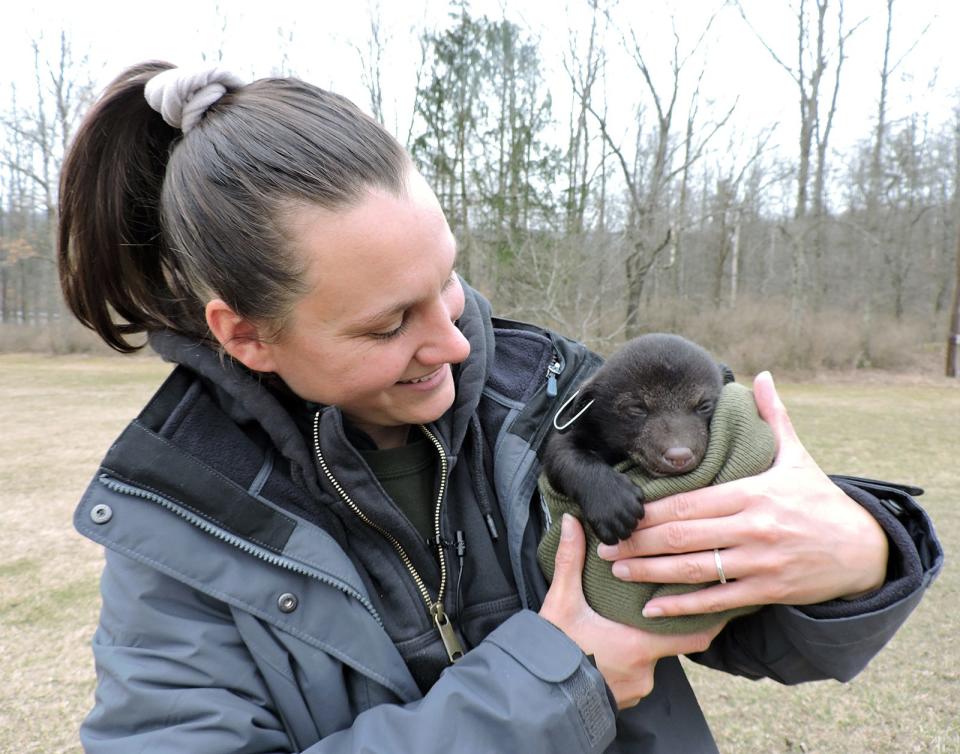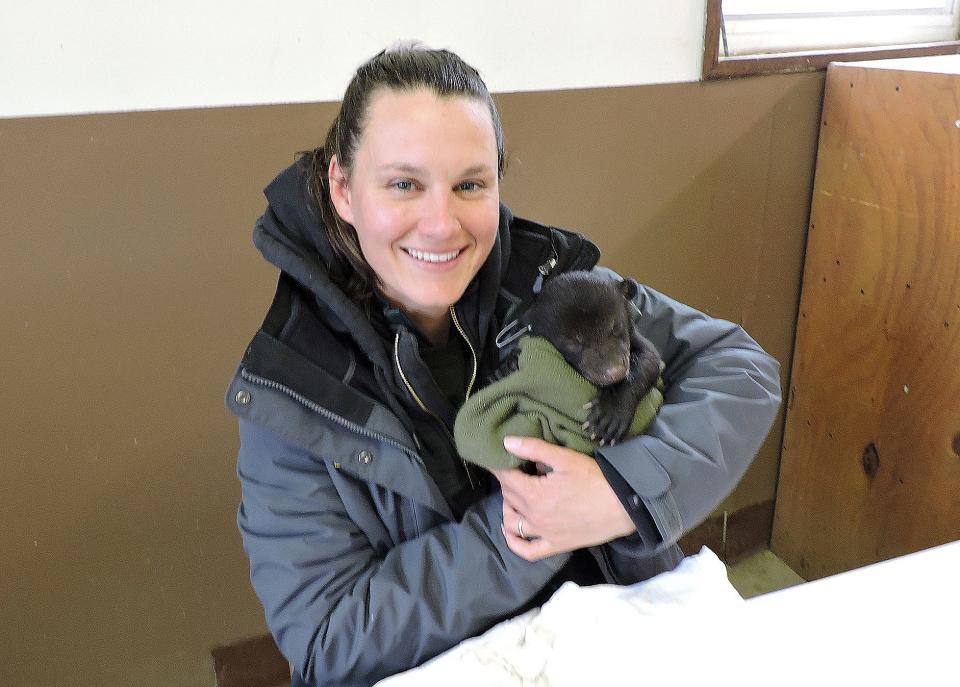Pennsylvania's black bears get healthy report during winter den checks
Black bears appear to be healthy during this winter's hibernation in Pennsylvania.
“So far, a lot of the bears are in good shape,” said Emily Carrollo, black bear program manager for the Pennsylvania Game Commission, during a mother bear den check Friday in northern Cambria County.

In considering this year's and last year’s den checks, “Every single bear we went to had a beautiful coat and was fat and happy. And the cubs were in really good shape,” she said.
“We go to anywhere from a dozen to three dozen dens every year, depending on the research we have going on in the state of Pennsylvania,” she said. This year is an in-between research year, and the team is only checking on eight dens and a few yearling bears.
Over the years, select female bears have been fitted with tracking collars that allow the agency’s staff to follow their movements. The wardens use a dart gun to tranquilize the denning mother bear, and the agency’s staff is able to monitor her health and her cubs.
The cubs are now 6 to 7 weeks old and weigh 3 to 5 pounds. They are fitted with ear tags that the agency will use if they encounter the bear in the future, such as if it is caught in a trap for being a nuisance bear or if it is harvested by a hunter.
The agency has historically radio-collared bears in the northeast, northcentral, and southwestern parts of the state. In 2021, the agency started testing out a new GPS tracking collar on bears in southcentral Pennsylvania.
Bears den in rocky areas where they can get out of the weather in ravines and large holes, but they also can be found on top of the ground in brushy areas, too. Some have also spent the winter under porches and decks of homes in wilderness areas. The cubs stay with their moms for a full year before moving out on their own.
Adult bears in the commonwealth average 175 to 300 pounds, but there are animals that have had the right habitat to grow to 700 to 800 pounds.
The game commission is looking to expand its research area.
The agency is considering placing collars on some bears in Wildlife Management Unit 4C including Schuylkill County in northeastern Pennsylvania. “It has quite a few bears,” she said.
In some cases, they are removing collars from bears that were involved in research projects that have concluded. In the southwest, she said bears have been fitted with tracking collars since the 1980s. Those studies were to “track reproduction, to track recruitment and to have females to bring abandoned cubs to during the winter time frame,” she said.
She hopes future research will also involve both male and female bears to monitor survival in different age classes.
Here's the plan:Biologist optimistic about reintroducing American martens in Pennsylvania
More resources:New warden supervisors optimistic about future responses to wildlife, investigations
How this winter compares to other years
A year ago, there were more mast crops like acorns than in the fall of 2022.
“This year because mast was spotty at best throughout Pennsylvania, it wouldn’t surprise me if we saw a bear that was in decent shape, but could be better," she said. "To be honest we really haven’t seen that, which is a good sign that they are getting enough food despite it being a poor mast year. It could have some level effect of population fluctuations.”
The bear population, which is estimated at just more than 15,000 bears statewide, is down from the past year.
“If the density of bear isn’t as high, there’s less competition for food on the landscape. Therefore even in poor mast years, black bears are able to consume enough calories and go into the hibernating season fat and happy,” she said.
How do bears hibernate?
“Black bears go through a metabolic change when they are actually denning,” she said. “Their metabolic activity drops upwards of 75%. Their breath rate drops only to four to six breaths per minute. Their heart rate drops, their temperature drops upwards of 12 degrees.” Normally a bear’s temperature is 99 to 100 degrees, and they drop to the high 80s during denning.
During this time of a slow metabolic rate, bears are able to occasionally get up and move during their hibernation.
“If it is warm out, black bears will occasionally get up and wander around, they will stretch their legs. They’re opportunistic. While they don’t eat during the hibernation period, if they come across a tasty bird feeder, I wouldn’t be surprised if a bear tries to eat it,” Carrollo said. “If the opportunity arises they will take it.”
Mother bears stay closer to their dens and cubs in winter than male bears. She said a male may walk a half mile and stretch its legs and den in a new location.
“They can move, especially if it’s pretty nice out. They might walk around and check things out to see what’s going on and then go back to sleep," she said.
Projects and upgrades planned:High energy prices create windfall for Pennsylvania Game Commission's projects
CWD research:About 600 wild deer to get GPS collars in southcentral Pennsylvania
Stop the spread:Spotted lanternflies found in more Pennsylvania counties. Here's what you need to know

When do bears wake up from hibernation?
In late spring, a bear’s metabolic rate speeds up and it seeks out food.
“Right now I would not be surprised if some male bears, especially in the next couple of weeks, start fully coming out of hibernation," she said. "By early mid-March with how warm it has been, I would assume that some green-up is going to occur a little earlier than it normally does. With that male bears and single bears, yearlings that got booted from their family group this past summer, are going to start getting up, wandering around and looking for food.” Females with cubs will start moving around about the beginning of April.
Bears may recover from mange
Since the 1990s, the agency has found bears with mange, which is a loss of hair caused by mites. While the disease is out there, Carrollo said it hasn’t caused a decline in the bear population. The bear population has grown since mange was first discovered in Pennsylvania.
She worked with Dr. Hannah Tiffin on a mange study, and that research revealed that bears with mild to moderate infections of mange have an 80% chance of recovery within a year, whether or not they are treated with the medicine Ivermectin by game commission personnel.
In severe cases of mange, where the animal becomes emaciated, the bears are euthanized.
“It’s a case by case basis,” she said.
Become BearWise
“Knowing that bears are going to start becoming more active within the next couple of weeks, it’s a good idea to start preparing,” she said. The key is removing anything from outside your home that would be appealing to a bear.
She offers the following tips through BearWise.org, an organization created and managed by bear biologists and managers across the country:
Never feed or approach bears. Intentionally feeding bears is illegal in Pennsylvania.
Secure your food, garbage and recycling. Food and food odors attract bears, so don’t reward them with easily available food, liquids or garbage.
Remove bird feeders when bears are active. Removing feeders during a bear’s active months is the best way to avoid creating conflicts with them.
Feed pets indoors when possible. If you must feed pets outside, feed in single portions and remove food and bowls after feeding. Store pet food where bears can’t see or smell it.
Clean barbecue grills after each use and make sure that all grease, fat and food particles are removed. Store clean grills and smokers in a secure area that keeps bears out.
If you see bears in the area or evidence of bear activity, you should tell your neighbors and share information on how to avoid bear conflicts.
If you'll be outside:
Pay attention to your surroundings and stay together. Walk, hike, jog, or cycle with others when possible. Keep kids within sight and close by.
Double bag your food when hiking and pack-out all food and trash. Don’t burn food scraps or trash in your fire ring or grill. Leaving scraps, wrappers, or even “harmless” items like apple cores teaches bears to associate trails and campsites with food.
Keep dogs leashed. Letting dogs chase or bark at bears is asking for trouble because you don’t want a bear to have to defend itself.
Set up camp away from dense cover and natural food sources. Cook as far from your tent as possible. Do not store food, trash, clothes worn when cooking, or toiletries in your tent.
If you see a bear before it notices you, don’t approach. Stand still, enjoy, then quietly move away. If a bear sees you, back away slowly. Never run as running may trigger a chase response. If a bear approaches, hold your ground, wave your arms and yell “Hey Bear” until it leaves. Stay with your group. If it keeps approaching, use bear spray.
If a black bear makes contact with you, do not play dead; fight back aggressively. Carry bear spray and know how to use it. Bear spray is proven to be the easiest and most effective way to deter a bear that threatens you.
If you have additional questions about bears, call the game commission at 833-PGC-Hunt.
Brian Whipkey is the outdoors columnist for USA TODAY Network sites in Pennsylvania. Contact him at bwhipkey@gannett.com and sign up for our weekly Go Outdoors PA newsletter email on this website's homepage under your login name. Follow him on Facebook @whipkeyoutdoors ,Twitter @whipkeyoutdoors and Instagram at whipkeyoutdoors.
This article originally appeared on Erie Times-News: Black bears are being checked by biologists, here's what they found

